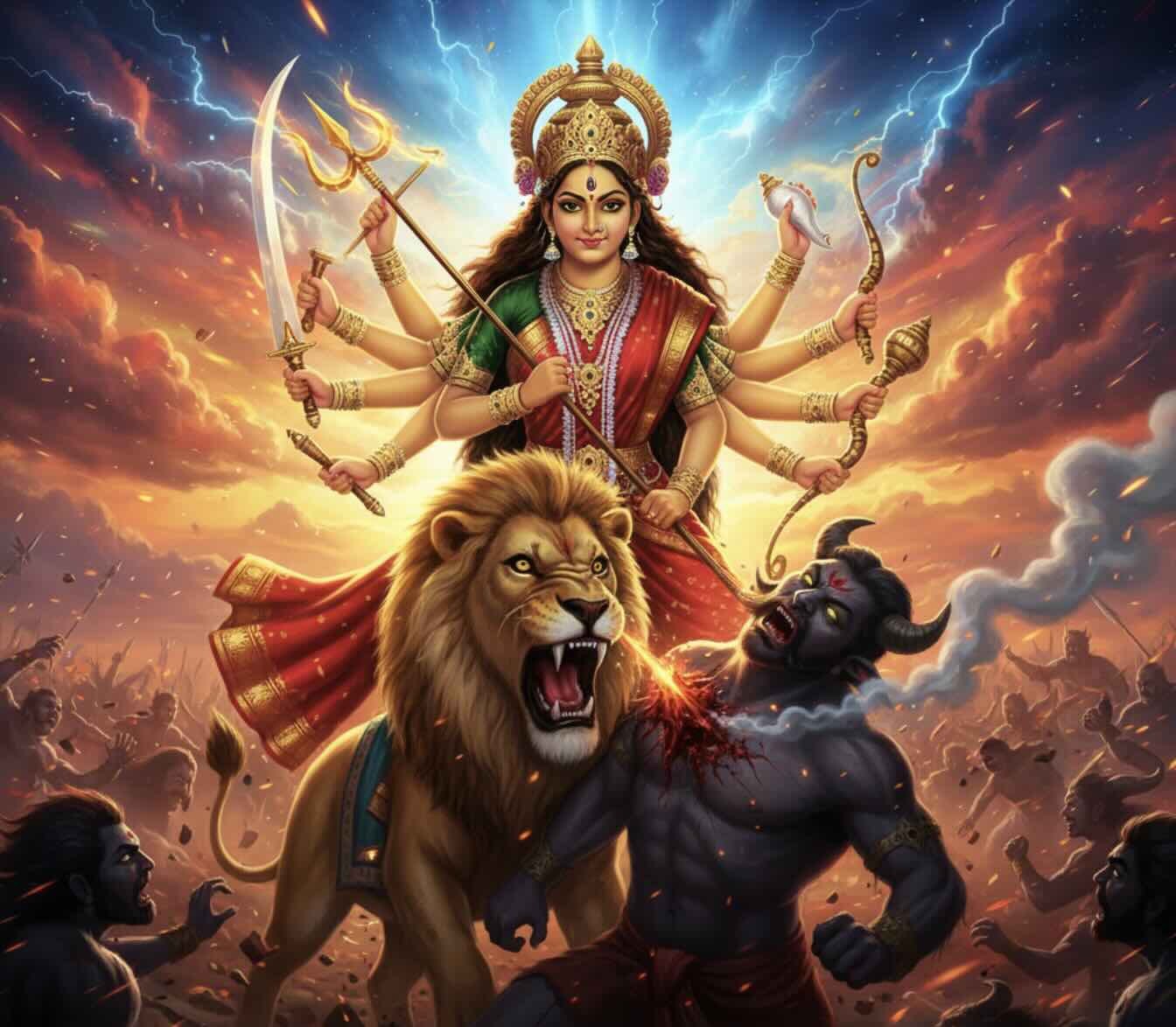Durga Puja and Dussehra 2025: A Divine Celebration of Good Over Evil
Embrace the divine festivities of Durga Puja and Dussehra from September 28 to October 2, 2025. Discover the important dates, sacred rituals, powerful mantras, and the cultural grandeur of India's most cherished festival.
Updated : 1 minute ago

Durga Puja & Dussehra 2025: The Ultimate Guide to the Festivities
India, a land of vibrant cultures and timeless traditions, gears up for one of its most significant and spectacular festivals - Durga Puja and Dussehra. Celebrated with immense fervor, this festival marks the victory of good over evil. Durga Puja honors Goddess Durga's triumph over the demon Mahishasura, while Dussehra (or Vijayadashami) celebrates Lord Rama's victory over the ten-headed demon king Ravana. In 2025, these festivals promise a grand spectacle of devotion, art, and community bonding.
Important Dates for Durga Puja and Dussehra 2025
Mark your calendars for the auspicious days of celebration. The festivities span over ten days, beginning with Sharad Navratri and culminating on Vijayadashami.
The Legend of Maa Durga and Mahishasura
Durga Puja commemorates the story from the Markandeya Purana, where the powerful buffalo demon Mahishasura created havoc, being invincible to any man or god. To defeat him, the divine trinity—Brahma, Vishnu, and Shiva—combined their powers to create Goddess Durga. Bestowed with ten arms, each holding a divine weapon, she rode a lion into battle and, after a fierce fight lasting nine nights, vanquished Mahishasura on the tenth day. This day is celebrated as Vijayadashami, the 'day of victory'.
Sacred Devi Mantra for Power and Protection
Chanting mantras dedicated to Goddess Durga is a central part of the worship, believed to bring peace, prosperity, and protection. One of the most powerful and widely recited mantras is:
सर्वमंगल मांगल्ये शिवे सर्वार्थसाधिके ।
शरण्ये त्र्यंबके गौरी नारायणि नमोऽस्तुते ॥
Sarva Mangala Mangalye, Shive Sarvartha Sadhike,
Sharanye Tryambake Gauri, Narayani Namostute.
Meaning: 'Oh, the most auspicious one, the consort of Lord Shiva, who fulfills all desires. I seek refuge in you, the three-eyed Gauri, Narayani. I bow to you again and again.'
Key Rituals and Celebrations
The festival is a beautiful blend of solemn rituals and joyous celebrations:
- Pandal Hopping: Communities erect elaborate temporary structures called 'pandals', each with a unique theme, housing magnificently crafted idols of Goddess Durga. Pandal hopping is a popular activity, especially at night when they are brilliantly lit.
- Pushpanjali: Offering flowers to the Goddess on Maha Ashtami morning, a deeply spiritual experience for devotees.
- Dhunuchi Naach: A devotional dance performed with a 'dhunuchi' (an earthen pot filled with burning coconut husk and incense) to the rhythmic beats of the 'dhaak' (a traditional drum).
- Sindoor Khela: On Vijayadashami, married women smear each other with vermilion ('sindoor') and offer sweets, wishing for a happy married life before the idol is taken for immersion.
- Ravan Dahan: In North India, Dussehra celebrations culminate with 'Ravan Dahan', where colossal effigies of Ravana, his son Meghnad, and brother Kumbhakaran are set ablaze, symbolizing the destruction of evil.
Conclusion: A Festival of Unity and Renewal
Durga Puja and Dussehra are more than just religious festivals; they are a cultural extravaganza that transcends barriers of age, caste, and creed. It's a time for families to reunite, for communities to celebrate together, and for everyone to reflect on the universal message that no matter how powerful, evil will always be vanquished by the forces of good. Prepare to immerse yourself in the divine aura and joyous spirit of Durga Puja and Dussehra in 2025.
❓ Frequently Asked Questions (FAQ)
1. When is Durga Puja in 2025?
The main Durga Puja rituals will be observed from Maha Shashthi on September 28, 2025, to Vijayadashami on October 2, 2025.
2. What is the difference between Navratri and Durga Puja?
Navratri is a nine-night festival dedicated to the nine forms of Goddess Durga. Durga Puja, especially popular in West Bengal, is a five-day event that takes place during the last five days of Navratri, celebrating Durga's victory over Mahishasura.
3. What is 'Sindoor Khela'?
'Sindoor Khela' is a ritual observed on Vijayadashami where married Hindu women apply vermilion (sindoor) on each other's faces, celebrating womanhood and praying for their husbands' long lives before the Goddess's idol is immersed.
4. Why is Dussehra also called Vijayadashami?
It is called 'Vijayadashami' which means 'the tenth day of victory'. It marks the victory of Goddess Durga over Mahishasura and also the victory of Lord Rama over Ravana, both of which are believed to have occurred on this day.
5. Where is the best place in India to experience Durga Puja?
Kolkata, West Bengal, is renowned for having the most grand and artistic Durga Puja celebrations. However, other cities like Delhi, Mumbai, and Varanasi also have vibrant celebrations.


